#black elk wilderness
Text
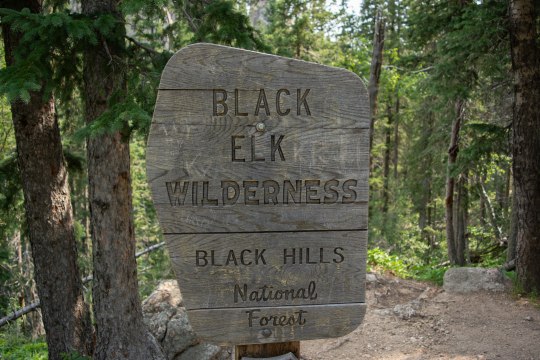
Black Elk Wilderness, Keystone, Pennington County, South Dakota, USA
Alex Moliski
#Black Elk Wilderness#Keystone#Pennington County#South Dakota#USA#US#United States of America#United States#North America
1 note
·
View note
Text
Only to the white man was nature a wilderness and only to him was the land ‘infested’ with 'wild’ animals and 'savage’ people. To us it was tame, Earth was bountiful and we were surrounded with the blessings of the Great Mystery.
Black Elk
Oglala Lakota Sioux

69 notes
·
View notes
Note
this isnt a defence of dnd but I was hoping to ask for clarification on a couple points you made that I dont fully understand and I'm clearly missing something. Namely that you mentioned racial connotations to the barbarian class and colonial connotations to the ranger class. Like I understand the term barbarian has imperial and xenophobic overtones to it but I can't tell where there are specific native stereotypes in it as it appears in dnd
yeah, i mean, a lot of the forms of racism that are at play here are deeply embedded into cultural norms and popular tropes, so if they're not stereotypes that affect you it can be easy to miss them. i'll be going solely by the DNDBeyond official class description: i've highlighted relevant sections

so, first of all, notice the very telling use of the word 'savage'. this is an extremely racialised term that is used against indigenous people to this day. yes, it's used here as an adjective rather than a noun, but in context it's telling, especially alongside 'tribe'--another very racialised word: europeans have 'ethnic groups' or 'nations', indigenous peoples have 'tribes'. 'savage tribe' is how indigenous people have been described for a long time, especially during the height of colonialism. some easy examples i found with a minute's googling:


note also the 'elk herd'. this class description is going to keep hammering home that barbarians are from nomadic backgrounds. a very common defense of the barbarian class is that it's based on norse berserkers--which is true to an extent, especially wrt 'rage', their headline class ability--but while the norse conducted raids and invasions, they lived in settlements. vast swathes of the conceptual makeup of the fantasy barbarian is derived from the colonialist imaginary of the nomadic, 'warlike', 'savage'.

moving on, we're hit with a barrage of direct comparisons to animals. now, i'm obviously not saying that it's racist to ever compare a character to an animal--but the barbarian class very explicitly represents a group of people with a certain lifestyle, and in the real world, comparing groups of people to animals has been a longstanding method of dehumanization that's been applied especially brutally to indigenous and Black victims of colonialism. and while 'animal spirits' is a fun vulfpeck song, here it's clearly invoked as a caricature of 'primitive' spirituality. why are the spirits 'fierce?' why must they be 'animal spirits?' why do other classes in DND invoke gods and demons, but the barbarian invokes 'spirits?'.

now it gets even more blatant. the barbarian is 'primal' -- they have an 'animal nature' -- they're explicitly contrasted to 'civilization' and associated with 'nature' -- this is a textbook example the 'noble savage' stereotype and it's as old as colonialism. and of course, the barbarian comes from 'tundra, jungle, or grasslands'.

so, here we have a very explicit confirmation of what i was talking here earlier re: barbarians very clearly intended to be nomadic peoples. they live in the 'wild places of the world' -- another colonialist trope rears its head here, the idea of an 'untamed wilderness' that can only be mastered by colonial domination, where the people are also 'wild'.

a 'frontier', huh? the idea of the 'rough frontier' is pure unadulterated colonial fantasy, straight outta manifest destiny. the 'frontier' is the area along which settler-colonialism takes place, where the civilized 'us' meets the savage 'them' in the context of the colonial national myth. and of course, the suggestion that your barbarian character might be a 'prisoner of war, brought in chains to ''civilized'' lands' is pretty clearly founded in the very racialised institution of slavery! (interesting to deploy the scare quotes around 'civilized' now when you were just drawing a fully unironic primal/civilized distiction a paragraph ago, wizards of the coast)

these same ideas about the ‘frontier’, about ‘wild lands’ and ‘the edges of civilization’ (and ‘civilization’ as a geographic notion with ‘borderlands’ that need to be ‘protected’) can incidentally also be seen here in the ranger’s flavour text. again, the idea that ‘civilization’ has a defined endpoint, beyond which there’s only ‘wilderness’ and ‘barbarians’ and ‘savage tribes’ has its origins in the roman empire, grandfather of modern imperialism, and the idea’s hold on the contemporary fantasy genre consciousness has its roots in manifest destiny and the american western frontier, where it serves the ideological purpose of obscuring the bloody and brutal wars of conquest that were waged nonstop against the many people who lived on the ‘uncivilized’ side of that imaginary dividing line in order to push the ‘frontier’ forward.

now, this part isn't on dnd beyond so i’m using a shitty little rulebook scan i found online bc i cba to properly pirate 5e again for this post, but by far the most played barbarian subclass is the path of the totem warrior. with the terms ‘spirit animal’ and ‘totem’, dnd 5e very specifically appropriates the real-world religous beliefs of native peoples. the term’s been beaten into the fucking ground over the last few years but this is some of the most cut-and-dry cultural appropriation i can imagine. and what does the path of the totem do? it gives the barbarian the abilities of animals, of course. Wolf Totems and Bear Totems and Eagle Totems, oh my! right back to the noble savage, the ‘wild man’, the dehumanizing animal comparisons we were talking about earlier.
now some of this, in a different context, could be innocuous and inoffensive. it’s not in a different context, though, it’s in this context--and in this context, it’s pretty clear that the ‘barbarian’ class has both feet planted firmly in the colonialist anti-indigenous imaginary. if you want a little more reading on this, this is a great article on the topic--but tldr: the colonial myth of the ‘wild frontier’ is load-bearing to the concepts of the barbarian and the ranger, and the barbarian in particular has anti-indigenous racist tropes marinating its flavor text.
235 notes
·
View notes
Text







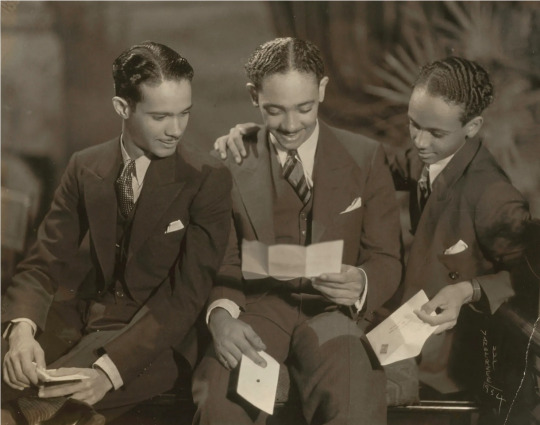
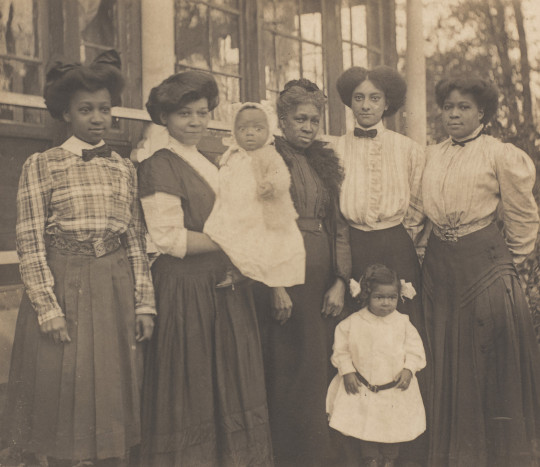

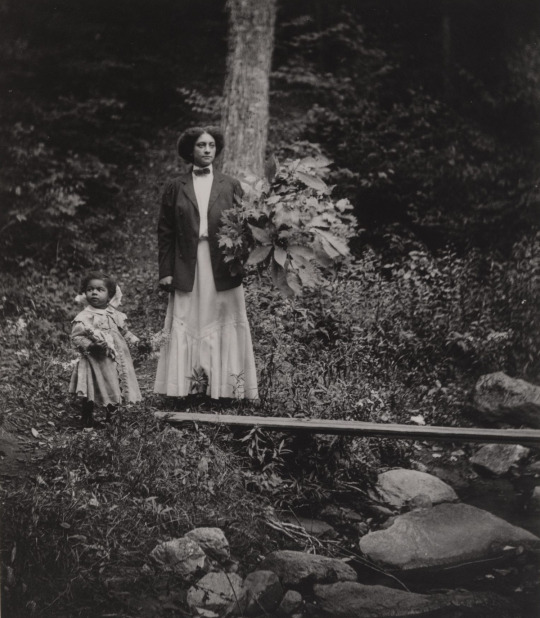
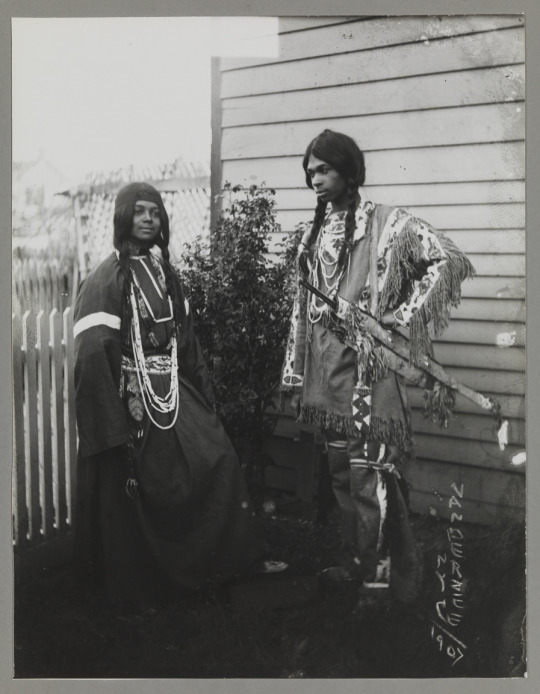

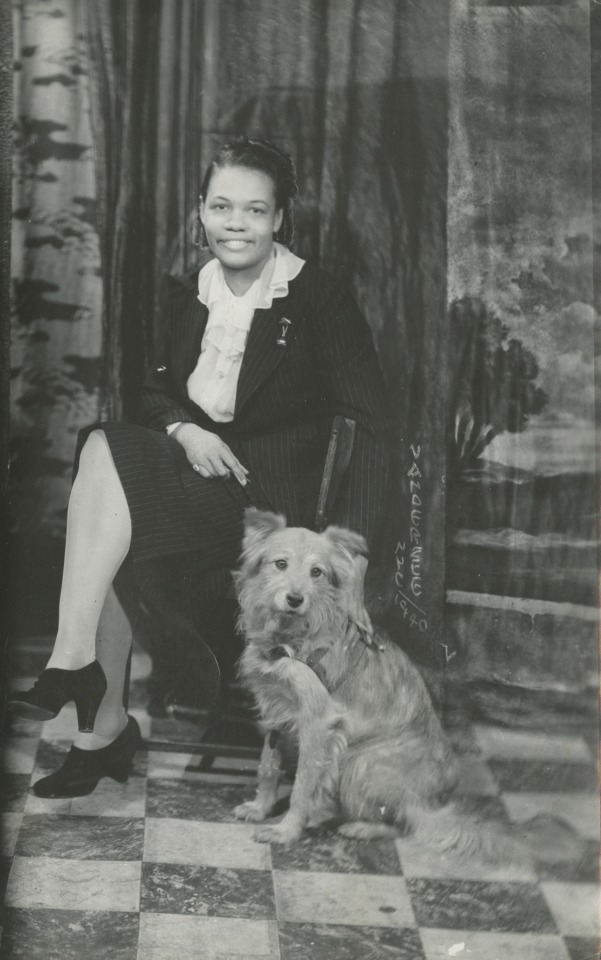
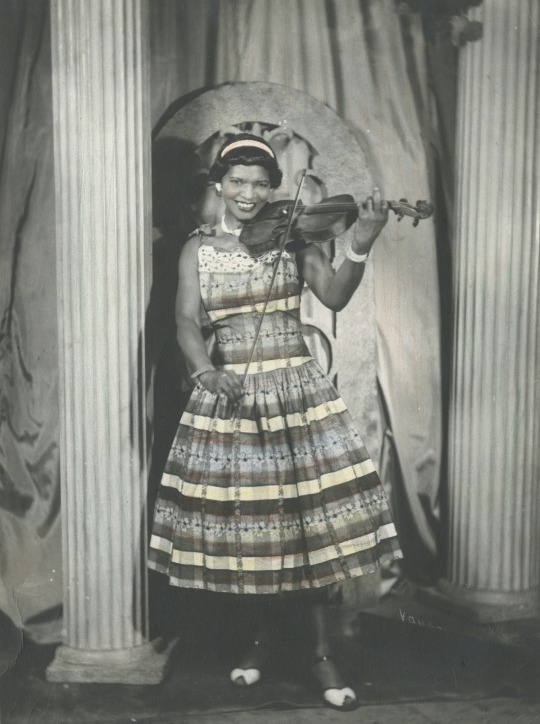

Black photographer James Van Der Zee established himself in Harlem, New York where he opened a portrait studio, intermittently from 1916 until 1968. His decades of documentation reveal the intimate lives of Black New York during some of its most significant cultural moments, including the Harlem Renaissance. During the 1920s, Van Der Zee work drew Black couples and families to his studio, showing the diverse experiences of of the rising Black middle (or upper working) class. He photographed Harlem residents in their homes, churches, and social clubs, providing an intimate look into the lives and labor one of America's most well-know, historic Black communities.
He lived to be almost 100, a Black man born into freedom, grew up during the collapse of Reconstruction, and lived to see the Civil Rights Act passed . . .
It’s a hard job to get the camera to see it like you see it. Sometimes you have it just the way you want it, and then you look in the camera and you don’t have the balance. The main thing is to get the camera to see it the way you see it. ~ Van Der Zee
(1) Beau of the ball (1926)
(2) Alpha Phi Alpha Basketball Team (1926)
(3) Lady with Wide-Brimmed Straw Hat w/ Dog (1934)
(4) A woman poses in Van Der Zee's studio (1920)
(5) A smiling couple (1930)
(6) Members of the Benevolent and Protective Order of Elks parade in Harlem (1931)
(7) Another Parade in Harlem (1924-26)
(8) Three men sit together reading through letters (1934)
(9) Women and children pose on Lenox Avenue (1909)
(10) The Black Jewish community of Harlem (1929)
(11) Kate and Rachel Van Der Zee explore the wilderness of Lennox, Massachusetts (1907)
(12) A Native American (possibly afroindigenous) Couple (1907)
(13) Nude with Butterfly (1936)
(14) A woman smiles her best friend (1940s)
(15) A violinist (1956)
(16) Jean-Michel Basquiat (1982)
Source: National Gallery of Art | Pennsylvania Academy of the Fine Arts
76 notes
·
View notes
Text
Only to the white man was nature a wilderness and only to him was the land ‘infested’ with 'wild’ animals and 'savage’ people. To us it was tame, Earth was bountiful and we were surrounded with the blessings of the Great Mystery.
Black Elk
13 notes
·
View notes
Text
The Kwamis
Alpha Kwamis:
Vitaa the Panda of Life
Shii the Crow of Death
Tikki the Ladybug of Creation
Plagg the Black Cat of Destruction
Graay the Wolf of Order
Prrysm the Platypus of Chaos
Stellar the Firefly of Space
Koree the Raccoon of Void
Elemental Kwamis:
Swaar the Dinosaur of Gravity
Longg the Dragon of Storm
Tonna the Feathered Serpent of Earth
Zeffyr the Griffin of Air
Duskk the Grim of Darkness
Nokk the Kelpie of Water
Emburr the Phoenix of Fire
Matto the Pterosaur of Aether
Kirrin the Qilin of Light
Kiikaa the Thunderbird of Electricity
Uunice the Unicorn of Magic
Ziima the Yeti of Glaciation
Timekeeper Kwamis:
Antiqq the Aurochs of Reversion
Shaash the Bear of Preservation
Sass the Cobra of Opportunity
Zipp the Dragonfly of Progression
Allta the Frog of Change
Keena the Lynx of Intuition
Frostt the Penguin of Stagnation
Fluff the Rabbit of Evolution
Apple the Red Panda of Lineage
Passtel the Snail of Patience
Faae the Spider of Destiny
Mataara the Tuatara of History
Delta Kwamis:
Harmonee the Ant of Cooperation
Sannar the Axolotl of Restoration
Fangg the Bat of Fatigue
Chaapa the Beaver of Innovation
Pollen the Bee of Subjection
Maggi the Binturong of Magnetism
Yanna the Bison of Victory
Blancca the Blackbuck of Inversion
Nooroo the Butterfly of Generosity
Duune the Camel of Perspective
Milli the Chameleon of Emotion
Purr the Cheetah of Agility
Reef the Coral of Sensitivity
Dess the Cougar of Apathy
Remmi the Coyote of Despair
Snapp the Crab of Adaptation
Llucie the Crocodile of Clarity
Fawnna the Deer of Wilderness
Barkk the Dog of Detection
Clikk the Dolphin of Sound
Olivv the Dove of Peace
Liiri the Eagle of Freedom
Tuskk the Elephant of Memories
Florra the Elk of Growth
Sorren the Falcon of Observation
Trixx the Fox of Deception
Elle the Gecko of Equality
Parra the Giraffe of Confusion
Ziggy the Goat of Imagination
Karrma the Goose of Justice
Verr the Gorilla of Sacrifice
Spikke the Hedgehog of Precision
Taamus the Hippopotamus of Density
Kaalki the Horse of Migration
Ravenna the Hyena of Scarcity
Gloss the Ibex of Friction
Izzy the Isopod of Instinct
Niisha the Jackal of Connections
Belaa the Jaguar of Imperception
Jellos the Jellyfish of Hatred
Kicc the Kangaroo of Avarice
Vexx the Komodo Dragon of Corrosion
Valoree the Lion of Courage
Donna the Llama of Attention
Vollee the Locust of Invasion
Xuppu the Monkey of Derision
Allces the Moose of Evocation
Duux the Moth of Hope
Baash the Mouflon of Strength
Mullo the Mouse of Abundance
Currio the Narwhal of Wonder
Attlantis the Octopus of Choice
Jiicho the Okapi of Dimension
Fleet the Ostrich of Guidance
Ziibi the Otter of Transformation
Tyyto the Owl of Secrets
Stompp the Ox of Determination
Lynn the Pangolin of Boundary
Ecco the Parrot of Communication
Duusu the Peacock of Psyche
Daizzi the Pig of Love
Glaace the Polar Bear of Endurance
Anjjel the Quail of Mercy
Habuu the Rattlesnake of Beauty
Ommen the Raven of Probability
Mannta the Ray of Immersion
Kaanda the Rhinoceros of Augmentation
Orikko the Rooster of Vitality
Finn the Salmon of Navigation
Aynna the Scarab of Reflection
Verriti the Scorpion of Truth
Daante the Seahorse of Fear
Selkee the Seal of Elusion
Flairr the Secretarybird of Passion
Poppy the Shark of Joy
Yuume the Sheep of Dreams
Frijj the Snow Leopard of Silence
Tinni the Squirrel of Diminution
Noodle the Stoat of Elasticity
Prrince the Swan of Loyalty
Acce the Thylacine of Isolation
Roaar the Tiger of Force
Scuut the Tortoise of Knowledge
Wayzz the Turtle of Protection
Teer the Vulture of Sorrow
Sotaa the Wolverine of Conflict
Drill the Woodpecker of Expansion
Divvi the Zebra of Duality
#20 canon plus 100 ocs#kwamis#kwami oc#kwami#oc kwami#plagg#tikki#updated list of everyone#hopefully its the last xD
93 notes
·
View notes
Text
Excerpt from this story from Anthropocene Magazine:
It’s nice to hike through the woods with a few friends, feeling a little closer to the natural world. Perhaps you even entertain the idea of being in harmony with your surroundings.
It turns out, you might be more like a chainsaw at a chamber music concert.
The noise of a group of chatty hikers, it turns out, can set off panic among nearby animals. Their response is even more intense than if you drove a 4-wheeled offroad vehicle. And the effects can echo through the wilderness a week later, as wildlife avoid the site of even a small number of noisy human intrusions, according to new research.
“Noise from recreation can carry far beyond a trail system, so understanding how noise alone can affect wildlife is important for management,” said Mark Ditmer, an ecologist at the U.S. Forest Service’s Rocky Mountain Research Station who helped lead the study.
The woods are likely becoming a noisier place, as more people head outside to play. Last year a record 168 million Americans took part in outdoor recreation, according to the Outdoor Industry Association, a trade group. The pandemic lockdowns that closed many indoor venues is credited for boosting a trend that had already taken hold years earlier.
Outdoor recreation is often portrayed as leaving a light imprint on the natural world than. Sporting goods companies such as Patagonia tout their environmental credentials. The backcountry motto of “Leave No Trace” suggests humans can pass through a place without a mark.
But there is a growing realization that even the most low-impact activities can still affect wildlife. Increased human presence near wildlife is associated with a spike in stress hormones, abandonment of some habitat and drops in reproduction, among other things.
The scientists set up a series of experiments in the forests of western Wyoming, which draws thousands of visitors to nearby places like Grand Teton and Yellowstone national parks. They set up video cameras, audio speakers and motion detectors along trails created by wild animals, at least 650 meters from any place regularly traveled by people. When a creature passed a point on the trail, a video camera would start recording and a speaker located 20 meters away would begin broadcasting an audio recording of people engaged in an outdoor activity. That included hikers, mountain bikers, runners, and people riding offroad vehicles. In some cases, the audio was of a small group of relatively quite people. In others, it was groups of more than four talking a lot. The recordings lasted for up to 90 seconds. All told, the speakers were triggered more than 1,000 times, with video capturing the reactions of mule deer, elk, moose, red fox, black bears, pronghorn antelope, cougars, coyotes and wolves.
When the scientists reviewed the images, it became clear that the sounds of outdoor recreation had a major effect. Wildlife was between 3.1 and 4.7 times more likely to flee when hearing those recordings than when they heard recordings of nature or nothing at all. They also showed signs of being more guarded and vigilant for 2.2 to 3 times longer after hearing recreation-related noises, the scientists reported last week in Current Biology.
8 notes
·
View notes
Note
1, 3, 9, 20, 25, 27, 28, 39, 45, 47 SORRY THIS IS SO MANY LOLL
o my goodness ok im putting a cut here for everyone's sanity cause all these questions got me excited
Do you have a favorite place near you to “touch grass”?
theres a little woodsy park near my house just within easy walking distance which is easy to get into regardless of time of day or night and has an incredible hill where you can sit under an oak tree in the tall grass and watch the sun or the moon come up or set depending on time of day and year and i love love love it one of the only good things about my town i go up there for my Rituals And Things gkjhsf
3. If you could see any extinct species in the wild, what would it be?
im a sucker for megafauna id love to see an irish elk or an aurochs or a woolly mammoth that would be so so cool
9. Do you have a favorite nature photo you’ve ever taken?
here's some of the best photos ive ever taken in my life, and then some pictures from the hike back to the cabin when we realized the sun was setting sooner than we thought it would and it was about to get WAY too cold for how we were dressed


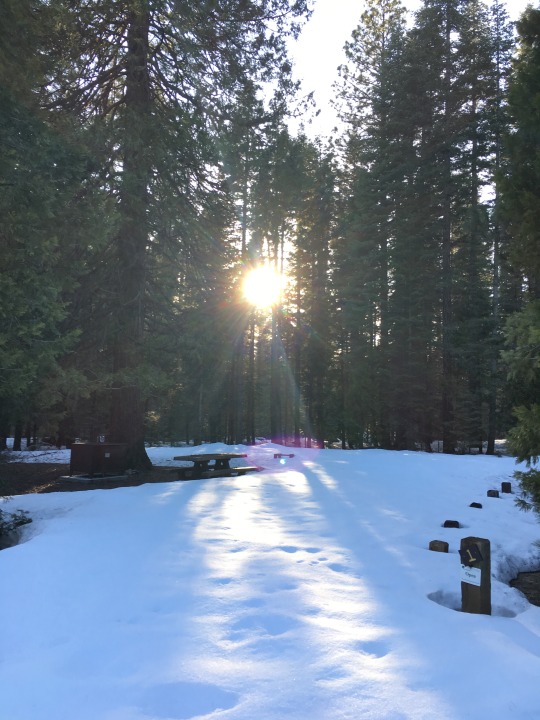
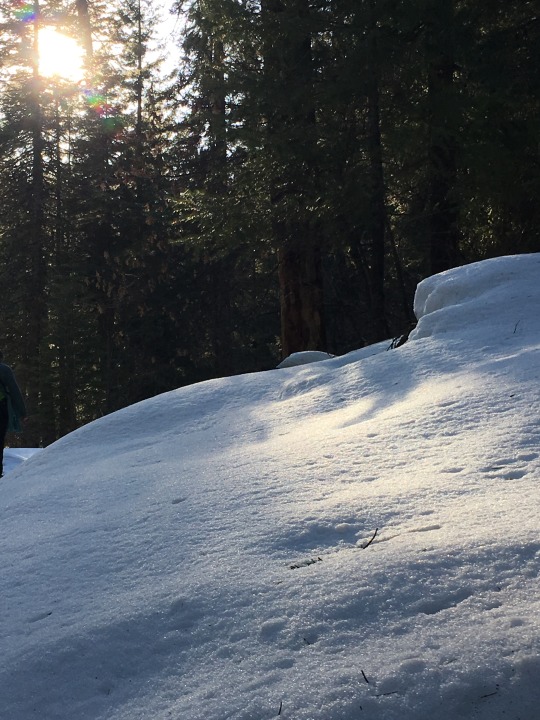
20. What’s your favorite poem or song lyric about nature?
definitely a gerard manley hopkins!!! he's my fave poet ever and half his work is about nature. i'm torn between two, tho: i think my favorite of all time, really my favorite poem entirely, is the windhover (ive been trying to copy and paste it here without ruining the formatting but it is not working alas so you must google it sorry), but the last stanza of another of my favorites of his poems, inversnaid, is also just. fucking killer
What would the world be, once bereft
Of wet and of wildness? Let them be left,
O let them be left, wildness and wet;
Long live the weeds and the wilderness yet.
25. What’s your favorite plant to grow yourself?
i unfortunately live in a terrible spot to grow stuff, the yard of my family's little house is like. straight dry clay and entirely shady, so my thumb has never gotten even the barest hint of green to it. one day id like to grow wheat or corn or some such tho
27. What’s your favorite outdoor activity?
honestly????? i love to just Sit And Observe. i used to love love love swimming in creeks and lakes and things, but obv i havent swum in anything for a very long time. hopefully i will again one dayy im also a big big fan of a fire for singing around. and to be honest shakespeare doesnt feel right unless its performed somewhere outdoors and beautiful now
28. What’s your favorite local animal you see all the time but still love?
ALL OF THEMMMMMM we get raccoons and possums and squirrels and mule deer and black tailed deer and crows and ravens and pigeons and rats and mice and apparently frogs i learned recently and newts and theyre all my best friends and i get so excited when i see them
39. What ecosystem do you consider your “home” ecosystem?
absolutely all american pacific northwest shit i love a temperate rainforest with redwoods and doug firs and such and then the deciduous layer underneath all ferns and moss and little creeks and then the harsh cliffs down to the beach all cold and foggy and windy. that's where i Belong easy peasy. i do also associate the more aggressively californian Beige Grassy Hills With Lonely Scrappy Little Coast Live Oaks or Valley Oaks On Top type biome with home and growing up, but its always been a little too harsh and dry and sunny for me here.
45. What is your favorite wildflower?
o god thats hard i love wildflowers. im a sucker for daisies, obv, and i love forget-me-nots and california poppies and indian paintbrush and columbine and and and
47. What is your favorite species of tree?
o no thats hard too!!!!! ummm probably oak trees, especially white oaks like the valley oak or the oregon white oak, especially the really big old wise looking ones, but i also adore sequoioideae and other conifers, unsurprisingly, and rowans and apple trees among others hold personal spiritual significance, and theres this specific kind of maple or sweetgum idk what it is but they grew outside the theatre i grew up in so they always make me nostalgic. OH and i LOVE the smell of california bay laurel thats the Good Summertime Smell for me
6 notes
·
View notes
Text

For #UACFillAugustWithArt. Map a Memory. Collage, acrylic paint, punched out photos (from a completely different project a few years ago).
In 1991, I worked for the US Forest Service in the Black Hills National Forest, based out of Hill City, South Dakota. Some of my favorite things were hiking to and from Harney Peak in the Black Elk Wilderness Area, and driving the Needles Highway and Iron Mountain Road.
#art journal#art journaling#visual journal#visual journaling#artjournal#artjournaling#visualjournal#visualjournaling#artjournalpage#artjournals#visualjournals#collage
2 notes
·
View notes
Text
NPC Spotlight: Julie "Bites-the-Bully" Lykos
Human-Born Philodox Black Fury Elder, 41, Zedakh, Elk Prairie Sentinels
CW: Blood.
Julie appears in 1975 as a well-built woman in her early 40s, 5'10", 193lbs, with a split brow, wiry, curly hair, and expressive, sage-colored eyes. Her face is deeply pockmarked with old scars that extend to cover most of her upper torso around her shoulders and cheeks in particular, making her facial features particularly pronounced in their expressiveness and her utter inability to hide what she's feeling. Her eyes tend to disappear behind a big lopsided smile when you can trick her into grinning. She often is seen wearing levis, bowling shirt or tank top, and one of her dad's WWII flight jackets.
She is most often seen in public working at Aloha Lanes at nights on the weekends, where she can make space for marginalized groups of weird kids like herself to socialize in safety on weekend nights while keeping up an appearance of being a part of the rural community of Trillium. Among garou she makes space for her own packmates and advocates strongly on behalf to ensure their voices are heard, whether from the traditional garou at the sept of the swift waters, to the traditional garou at sept of the trillium glade. She lives in a mobile home, in Steelhead springs with Dr. Esme "Leaping-Ghost" Marshall, Human-Born Theurge Child of Gaia Athro.
From a very young age, Julie was on the road traveling with her military family, but when the second world war broke out, she moved to Seattle to live with her aunt. Julie was always what her dad liked to call a "bent nail", a comment that had him fretting for her well-being. This reality followed Julie through her younger years. Generally speaking, the bent-nail got pounded. Most places Julie went, she never had much of a chance to get an impression long enough to get attached to anywhere, and nowhere did she ever truly belong. By the time she was in public school in seattle where all the kids already knew each other, Julie seldom went a week without coming home to her aunt's arms in tears. Unable to find other recourses, she spent a good portion of her teen years working malt shops, diners, whatever service industry job you could imagine, that's what Julie did. She was determined to go to college, get her degree, and move far away. She always dreamed of seeing alaska's wilderness like she read in her paperback novels, and felt like Seattle was always just beyond the reach of the world's wildest places.
When Julie hit puberty, the war ended, but not before it claimed both of her parents. In school, differences between her and the other girls only worsened. Her jawline hardened, and she started putting on muscle at the drop of a hat. She grew taller than most the girls at her school, and the worst of the bullying she faced was from other women. In short, Julie's self esteem was gone, and she was deeply depressed. When the bullying reached a head, Julie wound up having a breakdown at her school. Her aunt, ever-attentive, pulled her out of school and let her finish her education through homeschooling. In reality, she just let her ward have space and autonomy. Julie found an escape in reading. She especially loved Ursula K. Le Guin, and Leigh Brackett . By all measures, Julie should be the one with the strength to defend against everyone at the school, and none of the desire to do so.
But also, Julie had a plan. All those years she worked sweating in the service industry gave her what one would've needed back then to completely pay for her college, and rent a little studio apartment to herself. And Julie believed that at last she could put her childhood behind herself. Things went well for the first year, new class settling into their year at the school, she felt like she was finally able to let go of some of that bottled up anger, and then, on a hot, dry summer evening, she had her first change in the middle of the food hall at Evergreen college. And what it was wasn't some kind of new bully against her, no, it was seeing someone dump their drink on the head of another student, and before she knew it she was in the woods, panicked and her front covered in blood. Her aunt and a few members of the faculty were there, all kinfolk.
She is best known among the garou for fighting for The Fanum during the War of Chicago. In the aftermath of that conflict, Julie befriended Colleen "Shamisa" Fetner. Working with the Sept, the war started bloody, but ended with an uneasy peace between The Fanum and Sept of the Wind Catchers. Each working in tandem through Julie's efforts to unify them had The Fanum assaulted the Camarilla and sabbat simultaneously.At the end of the war, many garou died, including Julie's own pack mates, but every last known vampire in the city of Chicago were completely obliterated.
When Shamisa answered a calling to mentor a late changed garou in Seattle, she and Julie traveled there together. Julie lives in a trailer at Steelhead Springs just outside of Trillium with Esme. Opossum, a patron spirit of adaptability, has formed a strong bond with this Black Fury, and has followed her from her first pack to the Sentinels, which she now leads. Her stubbornness for her pack to be heard by the Red Talon Sept is what eventually led to Sept of the Trillium Glade opening itself to the rest of the garou nation, and among her pack and other Black Furies, Julie is respected for both her discipline and emotional intelligence, despite being very plain-worded.
Time spent living with Esme has drawn the two of them closer, though Julie hasn't been able to find the right words to open her heart.
Reason
Level 5, Gnosis 7
Description: Reason appears to be a partially broken labrys that's had one of it's blades shattered off. It's undergone a refurbishment with a new, short throwing axe handle, affixed on the other side with what looks like workshop hand tooling to clamp the ornate head to a utilitarian wood handle. On the handle is a sloppily woodburned word that can be barely read for the grime of use as 'Reason'. The spirit of a Freebooter named Iona "Kinslayer" is bound into this axe.
System: The signature Labrys of Bites-the-Bully, constructed during the War of Chicago in collaboration between the Sept of Jupiter and Sept of the Wind Catchers out of Julie's Mentor's Labrys when she and her Labrys were destroyed while defending the anchorhead. Attacks with Reason are difficulty 7 and to Strength + 3 aggravated damage. Activating this Fetish causes it to dramatically lighten in weight, enabling it to be thrown by anyone with a Strength of 4. Reason may be caught on it's return arc with a successful Dexterity + Athletics difficulty 7.
"I'm sure they'll listen to Reason"
#dead mountain#world building#NPC Spotlight#werewolf: the apocalypse#world of darkness#protagonists#Elk Prairie Sentinels#Black Furies#NPCs#Werewolf the Apocalypse
15 notes
·
View notes
Text
This New Park Gives Different Views of the Grand Canyon—with No Crowds
These sacred Indigenous lands in Arizona just got government protection. Here’s how to explore their hikes, wildlife, and impressive vistas.
— By Joe Yogerst | September 1, 2023

Red Butte, which the Havasupai people call Wii'i Gdwiisa (“Clenched Fist Mountain”), is one of many sacred Indigenous sites within Arizona’s new Baaj Nwaavjo I’tah Kukveni Grand Canyon National Monument. Named a national monument by President Joseph Biden in August 2023, the one-million-acre wilderness offers hiking, backcountry camping, and views of the Grand Canyon without the crowds. Photograph By Taylor McKinnon, Center For Biological Diversity
Grand Canyon National Park draws 4.7 million visitors a year to the northwest corner of Arizona to hike, camp, or watch wildlife. But most of them don’t realize that the lands within and surrounding the park are sacred to the region’s 12 Indigenous tribes, which include the Havasupai, Hopi, Navajo, and several bands of Paiute.
That changed on August 8 when President Joseph Biden signed a decree creating the Baaj Nwaavjo I’tah Kukveni—Ancestral Footprints of the Grand Canyon National Monument. Sprawling across more than 960,000 acres directly north and south of the national park, the new monument offers more rugged, less crowded recreation than its neighbor. It also provides a view of the landscape through Indigenous eyes.
“Baaj nwaavjo in Havasupai means ‘where the ancient people roamed,’” says Carletta Tilousi, coordinator of the Grand Canyon Tribal Coalition. “I’tah kukveni is the Hopi translation of ‘ancestral footsteps’. This reaffirms their creation stories.”
Here’s how the monument came to be, and how to explore it.
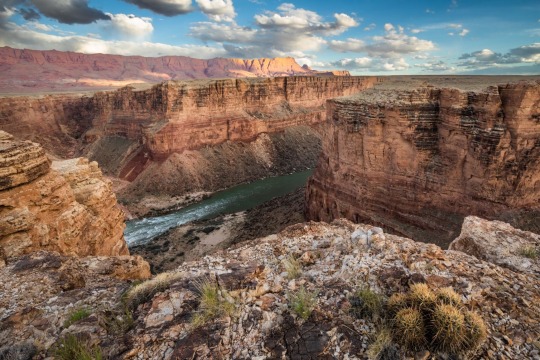
Baaj Nwaavjo I’tah Kukveni yields views of the Colorado River and Grand Canyon from a different perspective. Photograph By Amy S. Martin
How to Make a National Monument
It took two million years for the Grand Canyon itself to form and around 40 years for Baaj Nwaavjo I’tah Kukveni to become reality. “The protection for these lands is something the tribes have focused on since as far back as the 1980s,” says Amber Reimondo of the Grand Canyon Trust, a nonprofit devoted to preserving the region.
Many of these Indigenous people were expelled from their territory when Grand Canyon National Park was established in 1919. They campaigned for decades to receive stronger protection for their lands around the park, overcoming entities that wanted fewer legal obstacles to development and mining. After President Biden’s election in 2020, the 12 tribes formed a coalition which led to the lands receiving federal status.

Though the National Park Service oversees Grand Canyon National Park, monuments such as Baaj Nwaavjo I’tah Kukveni are run by the U.S. Forest Service (USFS) and the Bureau of Land Management (BLM). Monuments generally have fewer restrictions regarding their use (e.g., sometimes hunting or logging is allowed), as well as fewer facilities for visitors.
Fewer Amenities, Fewer Crowds
Like many national monuments, Baaj Nwaavjo I’tah Kukveni exudes raw nature. It has no bathrooms or visitor center; access is primarily via dirt roads or rough trails; you’ll need a four-wheel-drive to reach many sections of the park.
What it offers is solitude and peace amid the forests and grasslands of northern Arizona. You can gaze at the Grand Canyon without thousands of other people jostling for the same space, hike trails where yours are the only footsteps, and make camp at secluded spots. Plus you might encounter wildlife such as elk, black bear, mule deer, birds, or bison.
That solitude is also important to the Indigenous people. Tilousi says that when she visits the busy South Rim inside Grand Canyon National Park, “It’s very difficult for me to find a spot where I can offer prayers and offerings in a quiet way.” She feels that won’t be an issue in the off-the-beaten-track lands of the new monument.

Native plants including yucca flourish within Baaj Nwaavjo I'teh Kukveni National Monument. Photograph By Amy S. Martin
Exploring the Monument
The vast wilderness of Baaj Nwaavjo I’tah Kukveni is divided into three distinct sections or parcels, each with its own appeal.
The southernmost section, the Tusayan Ranger District/South Parcel, is the easiest to explore. Comprising 330,000 acres within the Kaibab National Forest, its pine woodlands and sagebrush prairie are accessible via Forest Service roads or Sections 35 through 37 of the Arizona Trail, an 800-mile hiking route stretching across the entire state.
The South Parcel also shows signs of human life, including the rusty hangar of the 1920s Red Butte Airfield and the 80-foot-tall Grandview Lookout Tower, which you can climb for views of the Colorado Plateau and the Grand Canyon.
The other sections of the monument, Kanab Plateau/Northwest Parcel and Rock House Valley/Northeast Parcel, are located beyond the North Rim section of Grand Canyon National Park.
“It's a big, remote wilderness,” says Michael Cravens, advocacy and conservation director of the Arizona Wildlife Federation. “I’ve never in my life been somewhere with night skies that spectacular.” But he cautions visitors “to be careful and prepared” for the extreme weather and topography. You can reach the northern parcels on BLM roads south of U.S. Highway 89A.

The vast House Rock Valley stretches through a portion of the new national monument. Photograph By Taylor McKinnon, Center For Biological Diversity
Stretched across the Kanab Plateau and Antelope Valley, the Kanab Plateau section has hiking routes through spectacular side canyons and to panoramic views such as Gunsight Point.
The Hack Trail drops down into the Kanab Creek Wilderness with its enormous red-rock canyons, a landscape almost as impressive as the Grand Canyon itself. Experienced hikers can continue down Kanab Creek to the Colorado River or along other trails to vertiginous overlooks along the North Rim.
Set beneath the Vermilion Cliffs National Monument, the Rock House Valley section of Baaj Nwaavjo I’tah Kukveni tumbles across sagebrush flats to the edge of Marble Canyon. Rugged hiking trails here include the Soap Creek Trail, which winds down from the Rapids/Badger Camp Overlook to a primitive campsite near the river.
Rough roads lead south to viewpoints for Rider Canyon, South Canyon, and other offshoots of the Grand Canyon. Here, you might even spot the North Rim’s resident bison herd, brought to the Arizona Strip in 1906 by Charles “Buffalo” Jones as part of efforts to save the species.
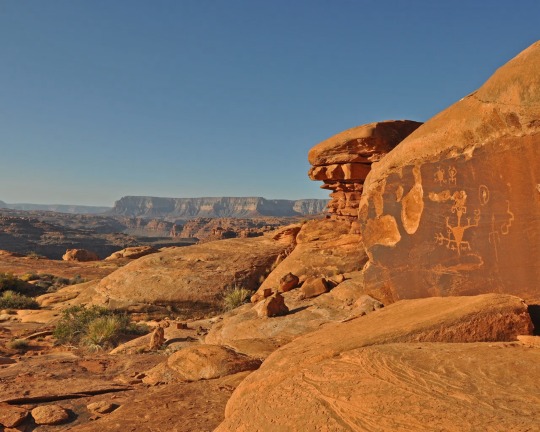
Ancient rock art can be spotted in the Kanab Creek Wilderness portion of Baaj Nwaavjo I’tah Kukveni National Monument. Photograph By Natpar Collection, Alamy Stock Photo

The Havasupai Indian Reservation in Arizona, which includes the Havasu Waterfall—part of the Havasupai Falls—is the current home of the Havasupai people. After the Grand Canyon became a national park, they were forcibly removed from their traditional homelands in the canyon and in nearby lands that will be part of the new national monument. Photograph By Mike Theiss National Geographic Image Collection
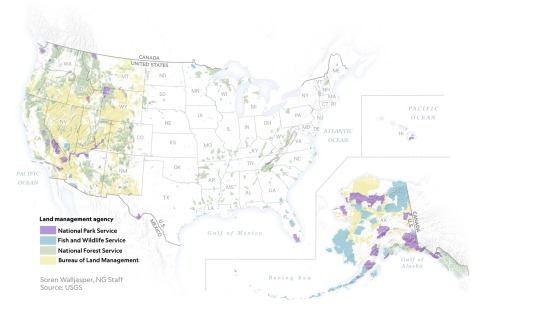
1 Million Acres of ‘Sacred’ Land Near Grand Canyon are Receiving New Protections! The designation of the land as a national monument, confirmed to National Geographic this week by the White House, will prevent new uranium mines and protect historically significant tribal lands.
#United States 🇺🇸 National Parks#New Park#Grand Canyan#Indigenous Lands#Arizona#Wildlife#Red Butte | Clenched Fist Mountain#Arizona | Baaj Nwaavjo I’tah Kukveni Grand Canyon National Monument#Center For Biological Diversity#President Joe Biden#Carletta Tilousi | Coordinator | Grand Canyon Tribal Coalition#Ancestral Footprints#Colorado River#Amber Reimondo | Grand Canyon Trust | Non-profit | Region Preservation#National Park Service#U.S. Forest Service (USFS) | The Bureau of Land Management (BLM).#Wildlife | Elk | Black Bear 🐻 | Mule | Deer 🦌 | Birds 🦅 | Bison 🦬#Hike Trails#Off-The-Beaten-Track Lands#Tusayan Ranger District | South Parcel#Kaibab National Forest 🌳#Colorado Plateau#Kanab Plateau/Northwest Parcel | Rock House Valley/Northeast Parcel#U.S. Highway 89A#Michael Cravens | Arizona Wildlife Federation#Kanab Plateau | Antelope Valley#Gunsight Point#Hack Trail#Vermilion Cliffs National Monument#Rock House Valley
3 notes
·
View notes
Text
Books
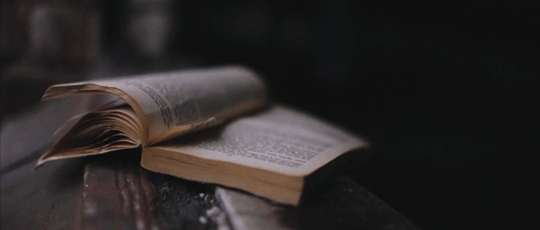
What I read in 2023
Tis The Season For Revenge by Morgan Elizabeth
Always Mine by Laura Pavlov
Her Way by Nicci Harris
His Pretty Little Burden by Nicci Harris
His Pretty Little Queen by Nicci Harris
The Piece That Fits by N.J. Gray
Heartless by Elsie Silver
Mile High by Liz Tomforde
Fresh Meet by Jasmin Miller
A Better Man by Carrie Elks
Suffer in Silence by Kelsey Clayton
Screams in Symphony by Kelsey Clayton
Our Thing by Nicci Harris
Cosa Nostra by Nicci Harris
Flawless by Elsie Silver
Consider Me by Becka Mack
The Right Move by Liz Tomforde
Play With Me by Becka Mack
A not so meet cute by Meghan Quinn
So not meant to be by Meghan Quinn
A long time coming by Meghan Quinn
A Photo Finish by Elsie Silver
Dirty Devil by Melissa Ivers
Keeping Denver by Sandy Alvarez and Crystal Daniels
Thorne Princess by L.J. Shen
Black Ties & White Lies by Kat Singleton
Rule Number Five by J. Wilder
Taste by Melanie Harlow
Tease by Melanie Harlow
Tempt by Melanie Harlow
Kiss and don’t tell by Meghan Quinn
Those Three Little Words by Meghan Quinn
Right Man, Right Tine by Meghan Quinn
Distance by Luna Mason
Glove Save by Teagan Hunter
Heat Haven by Sarah Blue
One Pucked Up Pack by Sarah Blue
That One Night by Emily Rath
Sleet Kitten by S.J. Tilly
Forbidden: Part One by Emilia Emerson
Pucking around by Emily Rath
Sinners anonymous by Somme Sketcher
Sinners consumed by Somme Sketcher
Sinners condemned by Somme Sketcher
Ever Mine by Laura Pavlov
Make You Mine by Laura Pavlov
Things We Never Got Over by Lucy Score
Unperfect by Susie Tate
Finn by BJ Alpha
Oscar by BJ Alpha
Things We Hide From The Light by Lucy Score
Coach by Devney Perry
Their Broken Legend by Nicci Harris
Gravity by Tal Bauer
Pucking Ever After Vol. 1 by Emily Rath
Thrust & Throttle by Emma Slate
Sugar and Skulls by LM Terry
The Ritual by Shantel Tessier
The Sinner by Shantel Tessier
The Sacrifice by Shantel Tessier
Washed in Blood by Ashley Lane
The Deal by Elle Kennedy
The Mistake by Elle Kennedy
The Score by Elle Kennedy
The Goal by Elle Kennedy
The Legacy by Elle Kennedy
Venom & Vengance by Emma Slate
Watercolor Skulls by LM Terry
The Rescue by Julie Weaver
Roses and Skulls by LM Terry
Runaway Love by Melanie Harlow
Simply Mine by Laura Pavlov

What I heard in 2023
Icebraker by Hannah Grace
Blindsided by Amy Daws
The Hardest Fall by Ella Maise
The Wall of Winnipeg and Me by Mariana Zapata
Don't Kiss the Bride by Carian Cole
Power Play by Maria Luis
Sin Bin by Maria Luis
Twisted Love by Ana Huang
Twisted Games by Ana Huang
Twisted Hate by Ana Huang
Twisted Lies by Ana Huang
The Simple Wild by K.A. Tucker
Wild At Heart by K.A. Tucker
Forever Wild by K.A. Tucker
Throttled by Lauren Asher
Focused by Karla Sorensen
Running Wild by K.A. Tucker
The Fine Print by Lauren Asher
Faked by Karla Sorensen
Forbidden by Karla Sorensen
Floored by Karla Sorensen
The Marriage Effect by Karla Sorensen
The Bombshell Effect by Karla Sorensen
The Ex Effect by Karla Sorensen
Home Game by Odette Stone
Puck Me Secretly by Odette Stone
It Happened One Summer by Tessa Bailey
All Rhodes Lead Here by Mariana Zapata
Under Locke by Mariana Zapata
Repeat by Kylie Scott
tattered by Devney Perry
timid by Devney Perry
Hook, Line, and Sinker by Tessa Bailey
tragic by Devney Perry
tinsel by Devney Perry
Until it fades by K.A. Tucker
Kulti by Mariana Zapata
Back to Navigation
7 notes
·
View notes
Text
Holidays 2.7
Holidays
Ballet Day
Beatles Hit America Day
Charles Dickens Day
Colin Kaepernick Appreciation Day
Constitution Day (Mexico)
Daniel Boone Escape Day
”e” Day
Hug an Addict or Alcoholic Day
International Clash Day
International Start a Blog Day
Laura Ingalls Wilder Day
Love Your Robot Day
National Black Grandmothers Day
National Black HIV/AIDS Awareness Day
National Foreskin Appreciation Day
National Homegating Day
National Jack Day
National Periodic Table Day
National Run-For-Your-Life Day
National Signing Day
Northern Territories Day (Japan)
No Talk Day
Rose Day
Send a Card to a Friend Day
Star Wars Podcast Day
Violet Day
Wave All Your Fingers At Your Neighbors Day
The Weekend Day (Canada)
Who Shall I Be Day
Food & Drink Celebrations
Fettuccine Alfredo Day
1st Tuesday in February
African-American Coaches Day [1st Tuesday]
Safer Internet Day [1st Tuesday]
Independence Days
Grenada (from UK, 1974)
Feast Days
Alfred E. Neuman Day (Church of the SubGenius; Saint)
Augulus, Bishop of London (Christian; Saint)
Blessed Eugénie Smet (Christian; Saint)
Chrysolius (Christian; Saint)
Colette of Corbie (Christian; Saint)
Day of Selene (Goddess of the Moon; Ancient Greece)
Egidio Maria of Saint Joseph (Christian; Saint)
Everyman’s Day
Feast of Mulk (Baha’i)
Ictinus (Positivist; Saint)
Just Another Day Day (a.k.a. No-Day Day; Pastafarian)
Luigi the Ice Cream Wolf (Muppetism)
Pius IX, Pope (Christian; Blessed)
Richard the Pilgrim (a.k.a. Richard, King of the West Saxons)
Romualdo, founder of the Order of Camaldoli (Christian; Saint)
Theodorus (a.k.a. Stratilates; Christian; Saint)
Tresain of Ireland (Christian; Saint)
Lucky & Unlucky Days
Perilous Day (13th Century England) [9 of 32]
Taian (大安 Japan) [Lucky all day.]
Umu Limnu (Evil Day; Babylonian Calendar; 6 of 60)
Unfortunate Day (Pagan) [9 of 57]
Premieres
Birds of Prey (Film; 2020)
Blazing Saddles (Film; 1974)
Breathless (Film; 1961)
The Color Purple (Film; 1986)
Elvis and Me (TV Mini-Series; 1981)
Hannah and Her Sisters (Film; 1986)
Lady Jane (Film; 1986)
The Lego Movie (Animated Film; 2014)
Letterkenny (TV Series; 2016)
Locke & Key (TV Series; 2020)
Manufacturing Consent, by Noam Chomsky and Edward S. Herman (Book; 1988)
Mickey’s Birthday Party (Disney Cartoon; 1940)
Norse Mythology, by Neil Gaiman (Stories; 2017)
Orpheus in the Underworld, by Jacques Offenbach (4-Act Opera; 1874)
Pinball Wizard, recorded by The Who (Song; 1969)
Pinocchio (Animated Disney Film; 1940)
Please Please Me, by The Beatles (Song; 1963)
Taxi Driver (Film; 1976)
Troilus and Cressida, by William Shakespeare (Play; 1603)
Today’s Name Days
Ava, Richard (Austria)
Držislav, Julijana, Maksim, Rikard (Croatia)
Veronika (Czech Republic)
Richard (Denmark)
Richard, Riho, Riko, Riku (Estonia)
Rikhard, Riku (Finland)
Eugénie (France)
Ava, Richard, Ronan (Germany)
Parthenios, Parthenis (Greece)
Rómeó, Tódor (Hungary)
Eugenia, Teodoro (Italy)
Daunis, Nelda, Richards, Rihards (Latvia)
Jomantė, Ričardas, Romualdas, Vildaugas (Lithuania)
Riborg, Rigmor, Rikard (Norway)
Romuald, Ryszard, Sulisław (Poland)
Partenie (Romania)
Vanda (Slovakia)
Ricardo (Spain)
Dick, Rikard (Sweden)
Teofil, Teofila (Ukraine)
Beau, Beaumont, Beverly, Bo, Boe, Jace, Jacey, Sinclair (USA)
Today is Also…
Day of Year: Day 38 of 2023; 327 days remaining in the year
ISO: Day 2 of week 6 of 2023
Celtic Tree Calendar: Luis (Rowan) [Day 17 of 28]
Chinese: Month 1 (Jia-Yin), Day 17 (Bing-Shen)
Chinese Year of the: Rabbit 4721 (until February 10, 2024)
Hebrew: 16 Shevat 5783
Islamic: 16 Rajab II 1444
J Cal: 8 Xin; Oneday [8 of 30]
Julian: 25 January 2023
Moon: 96%: Waning Gibbous
Positivist: 10 Homer (2nd Month) [Ictinus)
Runic Half Month: Elhaz (Elk) [Day 14 of 15]
Season: Winter (Day 49 of 90)
Zodiac: Aquarius (Day 18 of 30)
1 note
·
View note
Text
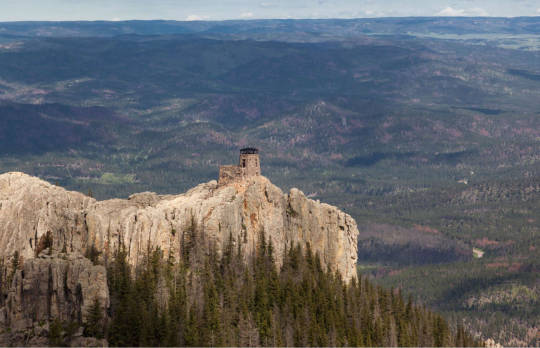
© Tami Freed/Shutterstock
Black Elk Peak, South Dakota
Black Elk Peak is the highest natural point in South Dakota and probably the best perch from which to gaze across Black Elk Wilderness, a remote swathe of the Black Hills National Forest named after a holy man of the Oglala Sioux. The peak is topped by a distinctive 1930s fire lookout tower, built from native stone, and looks over the dramatic landscape of pine forests, jagged peaks, canyons, lakes and open grasslands.
1 note
·
View note
Text
Yellowstone National Park: Discover the Geysers, Wildlife, and Natural Beauty
Yellowstone National Park, the crown jewel of America’s national parks, is a place where nature's raw beauty unfolds through a unique blend of geothermal wonders, abundant wildlife, and pristine landscapes. Spanning over 2.2 million acres, this park offers a front-row seat to some of the planet’s most extraordinary natural phenomena. Whether you're a wildlife enthusiast, a geology buff, or an outdoor adventurer, Yellowstone promises an unforgettable journey through its diverse environments.
The Iconic Geysers and Hot Springs

Yellowstone is home to half of the world's geothermal features, making it a hotspot for anyone eager to witness the planet’s geothermal power. The most iconic of these is Old Faithful, a geyser that has captivated visitors for generations with its regular eruptions, shooting water over 100 feet in the air. In addition to Old Faithful, the park boasts other geysers and hot springs, such as the mesmerizing Grand Prismatic Spring. This massive hot spring dazzles with its vibrant colors, created by thermophilic bacteria that thrive in its scalding waters. The Norris Geyser Basin, one of the hottest and most dynamic geothermal areas, showcases a variety of geysers, fumaroles, and steam vents.
A Haven for Wildlife

Yellowstone’s vast wilderness is home to an incredible array of wildlife. Visitors can spot grizzly bears, black bears, bison, wolves, and elk roaming freely in their natural habitats. The Lamar Valley, often referred to as the "American Serengeti," is one of the best places to observe wildlife in the park, offering unparalleled opportunities for spotting large herds of bison or a pack of wolves on the move. Whether it’s a lone bear wandering through the forest or an eagle soaring overhead, Yellowstone offers a wildlife-watching experience like no other.
Breathtaking Natural Beauty

Beyond the geysers and wildlife, Yellowstone’s landscapes are filled with jaw-dropping beauty. The Grand Canyon of the Yellowstone, with its golden-hued cliffs and the powerful Lower Falls, is one of the park’s most stunning features. Its steep walls and rushing waters create a dramatic vista that is perfect for photographers and nature lovers alike. Yellowstone Lake, the largest high-elevation lake in North America, provides a serene backdrop for kayaking, fishing, or simply enjoying the peaceful surroundings.
Adventure Awaits

For those seeking outdoor adventure, Yellowstone offers a range of activities that allow you to experience its beauty up close. With over 900 miles of hiking trails, the park is a paradise for hikers of all levels. Popular hikes like the Fairy Falls Trail and Mount Washburn lead you through lush forests, up mountain peaks, and past stunning geothermal features. In the winter, the park transforms into a snowy wonderland, offering opportunities for snowshoeing, cross-country skiing, and guided snowmobile tours.
Conclusion
Yellowstone National Park is a place where geysers erupt, wildlife roams, and nature’s beauty takes center stage. Whether you’re gazing at a geothermal wonder, watching bison graze in the valley, or hiking to a breathtaking viewpoint, Yellowstone offers endless opportunities to connect with the natural world. Discover the wonders of this remarkable park and create memories that will last a lifetime.
0 notes
Text
Best U.S. States for Hunting
Best U.S. States for Hunting
https://cecilraybaker.org/best-u-s-states-for-hunting/
When it comes to hunting in the United States, the abundance of game species, diverse landscapes, and rich hunting traditions make it a premier destination for outdoor enthusiasts. From the rolling plains of the Midwest to the rugged mountains of the West, each state offers unique hunting opportunities and experiences. Here’s a closer look at some of the best U.S. states for hunting:
Alaska
Known as the “Last Frontier,” Alaska boasts some of the country’s most pristine and untouched wilderness areas. With abundant populations of big game species such as moose, caribou, Dall sheep, and brown bear, Alaska offers unparalleled opportunities for adventurous hunters seeking an authentic wilderness experience. From remote backcountry hunts to coastal bear hunts, Alaska offers something for every hunter.
Texas
Everything is bigger in Texas, including the hunting opportunities. With vast expanses of private and public land, Texas is home to a wide variety of game species, including white-tailed deer, wild hogs, javelina, and exotic species such as axis deer and nilgai antelope. With liberal hunting regulations and a thriving hunting culture, Texas is a favorite destination for both resident and non-resident hunters alike.
Montana
With its rugged mountains, vast forests, and abundant wildlife, Montana is a paradise for outdoor enthusiasts. Known for its large populations of elk, mule deer, whitetail deer, and antelope, Montana offers a diverse range of hunting opportunities for hunters of all skill levels. Whether you prefer spot-and-stalk hunting in the mountains or still-hunting in the dense forests, Montana has something for everyone.
Wyoming
With its wide-open spaces and diverse habitats, Wyoming is a top destination for hunters seeking trophy big game species such as elk, mule deer, pronghorn antelope, and bighorn sheep. Wyoming’s extensive public lands, including national forests, BLM lands, and state wildlife management areas, provide ample opportunities for DIY hunts and backcountry adventures.
Colorado
With its towering peaks, dense forests, and vast expanses of high plains, Colorado offers many hunting opportunities for outdoor enthusiasts. Known for its large populations of elk, mule deer, black bear, and mountain lion, Colorado attracts hunters from across the country in pursuit of trophy game. Whether you prefer hunting in the high country or the foothills, Colorado’s diverse landscapes provide endless opportunities for adventure.
Conclusion
The United States offers many hunting opportunities for outdoor enthusiasts of all skill levels. Whether you’re seeking trophy big game species in the rugged wilderness of Alaska, the wide-open plains of Texas, the majestic mountains of Montana, the vast expanses of Wyoming, or the diverse landscapes of Colorado, there’s something for everyone in the best U.S. states for hunting. So pack your gear, grab your rifle or bow, and head out into the great outdoors for an unforgettable hunting experience.
via Cecil Ray Baker | Outdoors https://cecilraybaker.org
August 10, 2024 at 06:59AM
0 notes